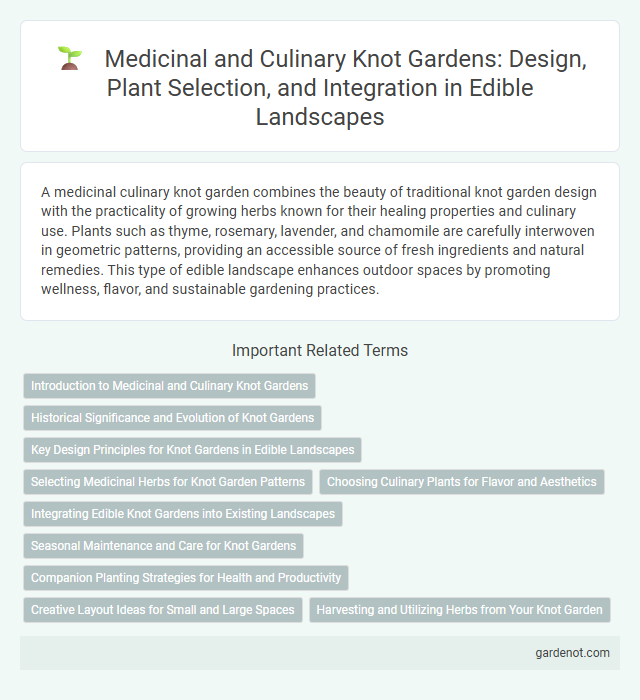A medicinal culinary knot garden combines the beauty of traditional knot garden design with the practicality of growing herbs known for their healing properties and culinary use. Plants such as thyme, rosemary, lavender, and chamomile are carefully interwoven in geometric patterns, providing an accessible source of fresh ingredients and natural remedies. This type of edible landscape enhances outdoor spaces by promoting wellness, flavor, and sustainable gardening practices.
Introduction to Medicinal and Culinary Knot Gardens
Medicinal and culinary knot gardens combine ornamental design with functional plantings, featuring herbs known for their therapeutic and flavor-enhancing properties. These gardens optimize space and biodiversity by arranging medicinal plants such as lavender, thyme, and sage in intricate, interwoven patterns that facilitate easy access and aesthetic appeal. Incorporating traditional knowledge with modern permaculture principles, medicinal culinary knot gardens support both health and culinary uses while promoting sustainable gardening practices.
Historical Significance and Evolution of Knot Gardens
Medicinal culinary knot gardens originated in medieval Europe, serving as practical spaces where herbs used for both cooking and healing were intricately woven into geometric patterns. These gardens evolved from simple herb beds into symbolic landscapes reflecting Renaissance ideals of order and symmetry, emphasizing the dual purpose of aesthetics and utility. Throughout history, knot gardens exemplified the fusion of medicinal knowledge and culinary tradition, shaping the design of edible landscapes in noble estates and monastic settings.
Key Design Principles for Knot Gardens in Edible Landscapes
Key design principles for medicinal culinary knot gardens in edible landscapes emphasize precise geometric patterns that interweave herbs with known therapeutic properties such as thyme, lavender, and sage. The garden layout maximizes space efficiency while ensuring accessibility for harvesting and promoting plant health through companion planting techniques. Incorporating aromatic and visually contrasting species enhances sensory appeal and reinforces the garden's functionality for both culinary and medicinal use.
Selecting Medicinal Herbs for Knot Garden Patterns
Selecting medicinal herbs for a culinary knot garden requires prioritizing plants with proven therapeutic benefits such as thyme, rosemary, and lavender, which enhance both flavor and health properties. Arranging these herbs in intricate patterns maximizes visual appeal while facilitating easy access and harvest, essential for maintaining plant health and potency. Incorporating medicinal herbs known for anti-inflammatory and digestive benefits ensures the garden serves dual roles in culinary use and natural wellness.
Choosing Culinary Plants for Flavor and Aesthetics
Selecting culinary plants for a medicinal culinary knot garden requires balancing flavor profiles with visual appeal to create an engaging sensory experience. Herbs like rosemary, thyme, and sage offer potent medicinal properties while contributing aromatic complexity and vibrant greenery. Incorporating colorful, edible flowers such as nasturtiums and chive blossoms enhances the garden's aesthetic richness and provides diverse culinary uses.
Integrating Edible Knot Gardens into Existing Landscapes
Integrating edible knot gardens into existing landscapes enhances both aesthetic appeal and functional utility by combining culinary and medicinal plants in intricate, geometric patterns. These gardens optimize space through dense planting of herbs like rosemary, thyme, and lavender, which offer therapeutic benefits alongside flavor enhancement. Incorporating native, drought-resistant species ensures sustainability and resilience, making edible knot gardens ideal for eco-friendly landscape design.
Seasonal Maintenance and Care for Knot Gardens
Seasonal maintenance of medicinal culinary knot gardens involves regular pruning to promote healthy herb growth and prevent overcrowding. Mulching during colder months protects roots from frost while preserving soil moisture and suppressing weeds. Ensuring proper irrigation in dry seasons optimizes the potency and flavor of medicinal herbs used in culinary applications.
Companion Planting Strategies for Health and Productivity
Medicinal culinary knot gardens utilize companion planting strategies to enhance plant health and boost productivity by pairing herbs and edible plants that support each other's growth. Plants like chamomile, lavender, and rosemary improve soil quality and repel pests while promoting robust medicinal properties in neighboring culinary herbs such as basil, thyme, and sage. This synergistic planting approach reduces the need for chemical interventions, fostering a sustainable and thriving edible landscape.
Creative Layout Ideas for Small and Large Spaces
A medicinal culinary knot garden combines herbs like thyme, rosemary, and lavender in intricate, geometric patterns that maximize space efficiency while enhancing visual appeal. Small spaces benefit from compact, raised beds arranged in symmetrical knots, ensuring easy access and optimal sunlight exposure for each herb. Large gardens can incorporate winding pathways and tiered sections to create dynamic, layered designs that showcase the diversity of medicinal and culinary plants.
Harvesting and Utilizing Herbs from Your Knot Garden
Harvesting herbs from your medicinal culinary knot garden at the peak of their essential oil production ensures maximum flavor and therapeutic benefits. Use sharp scissors to snip leaves and stems early in the morning after dew evaporation for optimal potency. Incorporate freshly harvested herbs like rosemary, thyme, and basil into teas, tinctures, and culinary dishes to harness their natural medicinal properties effectively.
Medicinal culinary knot garden Infographic

 gardenot.com
gardenot.com